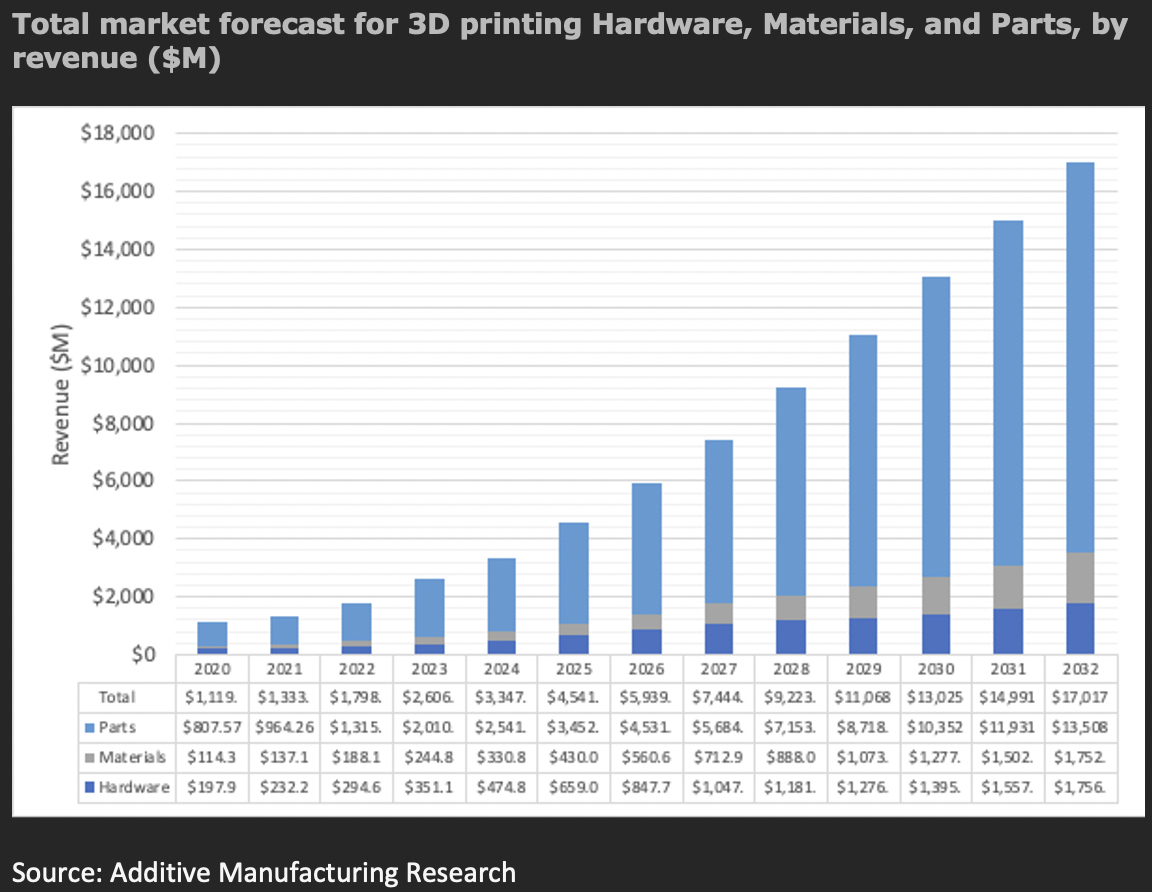As the sector that literally fuels our entire industrial society, energy may be poised to benefit most from the adoption of 3D printing. And, according to the new titled “Additive Manufacturing in the Energy Sector: Market Analysis & Forecast” report from Additive Manufacturing (AM) Research, this means a $17 billion revenue opportunity by 2032. The study, which examines the use of 3D printing in the oil & gas, nuclear and renewable energy segments, estimates that, as of 2023, the energy market as a whole represented $2.6 billion in AM revenue activity.
As the world enters a new era of supply chain resilience and sustainability, the energy sector will surely be making use of 3D printing at an increasingly rapid rate. For oil & gas, this is largely driven by the need to make more efficient use of dwindling resources in order to get more output from less input and, therefore, offset rising energy prices. Optimized designs and logistics networks driven by 3D printing can do just that and whatever advancements are made there can be ported over to other energy segments, like renewables and nuclear, where AM offers additional benefits specific those technologies as well.

Impellers 3D printed for Shell’s Dutch refinery. Image courtesy of Shell.
“Additive Manufacturing in the Energy Sector” focuses on the present state and future prospects of additive manufacturing (AM) in this industry. It delves into how AM is evolving to offer on-demand production capabilities, minimize operational interruptions, and improve efficiency by enabling more sophisticated part designs. The piece also discusses existing obstacles, including constraints related to materials, the necessity for compliance with industry regulations, and the demand for sector-specific certifications and standards, which are currently being tackled. Furthermore, the report presents a market forecast, underscoring the substantial growth potential of AM in the energy sector, with an analysis that breaks down this potential by technology, material type, and application areas.

The report features insights into a number prominent companies and organizations, including Shell, GE Power & Renewable Energy, ExxonMobil, Baker Hughes, ConocoPhillips, and Westinghouse, along with regulatory and standard-setting bodies like the American Petroleum Institute, DNV GL, and Lloyd’s Register. Additionally, key players from the AM industry such as Stratasys, 3D Systems, EOS, Desktop Metal, and Markforged are included.
Authored by Oliver Smith from ReThink Additive, the “Additive Manufacturing in the Energy Sector: Market Analysis & Forecast” report benefits from his extensive expertise in the 3D printing industry. Oliver Smith, having recently been a part of Stratasys’ consulting division, brings over a decade of experience working with clients in 3D printing, particularly those in the energy sector.
Subscribe to Our Email Newsletter
Stay up-to-date on all the latest news from the 3D printing industry and receive information and offers from third party vendors.
Print Services
Upload your 3D Models and get them printed quickly and efficiently.
You May Also Like
The Market and Industry Potential of Multi-Material 3D and 4D Printing in Additive Electronics
Additive manufacturing leverages computer-based software to create components for products by depositing either dielectric or conductive materials, layer by layer, into different geometric shapes. Since its birth in the 1980s,...
3DPOD 262: Bio-inspired Design for AM with Dhruv Bhate, Arizona State University
Dhruv Bhate is an associate professor at Arizona State University. There, he looks at structures, materials, and design. Previously, he worked at PADT as well as in the semiconductor and...
3DPOD 261: Tooling and Cooling for AM with Jason Murphy, NXC MFG
Jason Murphy´s NXC MFG (Next Chapter Manufacturing) is not a generalist service; instead, the company specializes in making tooling. Using LPBF and binder jet, the company produces some of the...
3DPOD 260: John Hart on VulcanForms, MIT, Desktop Metal and More
John Hart is a Professor at MIT; he´s also the director of the Laboratory for Manufacturing and Productivity as well as the director of the Center for Advanced Production Technologies....
































